Extreme weather, high premiums, consumer awareness through hard market

Only 14% of people in the U.S. have flood insurance, while as many as two-thirds mistakenly believe their current policy covers flood-related damage, according to a recent survey commissioned by Selective and conducted by The Harris Poll. And as home premiums reach record highs, largely in part due to extreme weather, consumers and agents alike face a common question: What steps can be taken to successfully navigate through this difficult, complex market?
For consumers, awareness and knowledge about insurance—including what’s covered, what’s not covered, what risks they’re most vulnerable to and how to file a claim—is crucial. All of that considered, the mandate for agents is clear: equip your clients with that very knowledge and awareness. Policyholders will benefit, and so will your resilience, reputation and business.
What to focus on in consumer communications?
In consumer engagement and advocacy, it is vital for agents to:
Clarify what’s covered—and what’s not: A standard homeowners insurance policy typically covers a policyholder’s home, other structures on their property, personal belongings, liability for accidents, and additional living expenses if the home becomes uninhabitable. Standard policies do not cover flood, earthquake, wear and tear, pests, or intentional damage done by the homeowner. Considering the fact that so many people are both underinsured and under informed, these are key points to focus on with any consumer exploring coverage options for their home.
Have an honest conversation about risk: Simply put, previously deemed high-risk flood areas are no longer the only regions of concern. GPS sensors and satellite data reveal a dual threat: not only are sea levels rising, but the land on which major cities are built is also sinking. This combination poses a significant risk to infrastructure. Further, 25% of flood claims come from outside FEMA-designated high hazard zones.
Home and business owners are gearing up for what weather experts predict to be the most active hurricane season on record. This underscores the critical importance of engaging in open and honest discussions about risk assessment and ensuring adequate coverage as the stormy season approaches. Ensure you document flood covering offerings with your insured. A best practice is to send a declination of coverage form to your insured for signature which includes wording that the declination applies to all future renewals.
Prepare policyholders for the claims process well ahead of any potential claim: Another factor that many consumers are unaware of is the importance of the steps to take after signing up for that policy.
Taking a home inventory is an often overlooked step in the coverage process, so here are some tips to share and emphasize with consumers:
No time is better than now to do that home inventory—do it ASAP, before disaster strikes.Take pictures and videos of your belongings; even just a walking video tour of your home goes a long way in obtaining adequate documentation for any potential claims.Save your receipts, statements, and invoices for major purchases
The hard market, extreme weather and emerging technologies
And as far as anyone can tell, the hard market—which has largely been driven by factors such as the pandemic, inflation and broader economic uncertainty—is likely to continue. However, in addition to developing more accurate flood maps, emerging technologies can allow insurers to offer more precise pricing and coverage.
Considering all of these factors, many insurance companies are turning to AI-based technology to assess and manage the risks posed by extreme weather. These technologies help insurers analyze data to predict and mitigate potential losses. Companies like Kettle use AI to evaluate property in California for wildfire risk, analyzing factors such as weather patterns, vegetation, and historical fire data. This allows Kettle to offer coverage in high-risk areas where traditional insurers have withdrawn.
And companies like FloodFlash use a parametric insurance model, which is different to traditional indemnity cover and comes with some big advantages. On-the-ground sensors monitor flood levels in real-time. When flooding reaches a certain height, these sensors trigger automatic payouts, providing immediate financial relief without requiring lengthy claims adjustments.
For consumers, smart home devices offer significant cost savings. For example, a smart water sensor can alert homeowners if there is a leak, prompting immediate action. Recognizing the value of these technologies, many insurance companies may incentivize homeowners with premium discounts. These discounts are offered because advanced smart home technologies can help detect problems early, reducing the likelihood of expensive claims.
“Emerging technologies like AI and smart devices are becoming relevant in flood insurance,” says Mark Wolf, president of Big I Advantage, home of the national Big “I” Flood program. “Smart home devices including water sensors are being used by homeowners to detect leaks early, and some insurers are incentivizing the use of this technology as it can reduce the likelihood of significant claims.”
While the landscape of insurance evolves and technology advances, one steadfast element remains: the indispensable role of an agent. An insurance agent serves as a trusted guide to help empower consumers to continue protecting their assets, properties, and overall well-being. Their presence ensures personalized care and informed decision-making, for years to come.
In this market, an informed, empathetic approach to client communications is more vital than ever, and by taking the above steps, agents position themselves and their clients for success through the headwinds.







